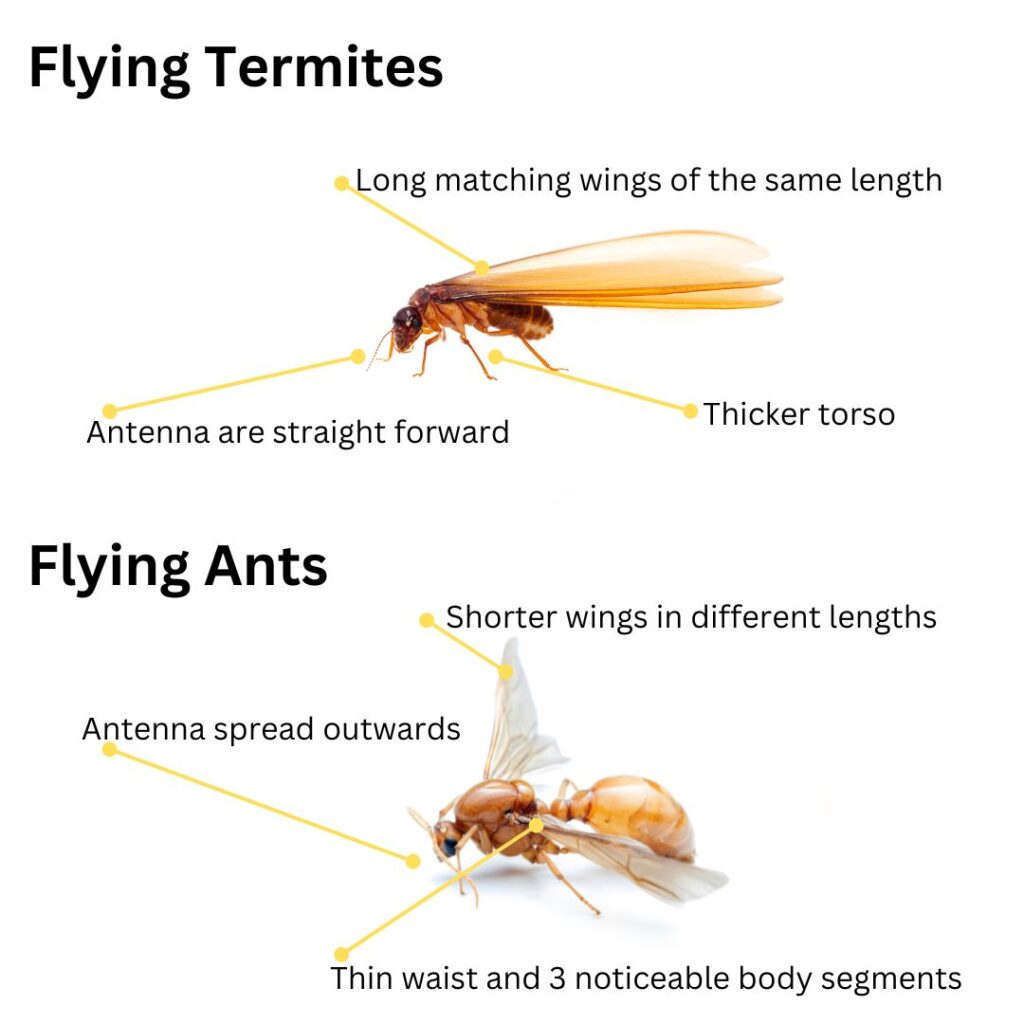Understanding Flying Termites: Essential Insights for Homeowners
Flying termites, commonly referred to as “swarmers,” typically emerge during transitional seasons when humidity levels rise, especially noticeable in spring and early summer. These pests are often hidden during the colder months, quietly consuming wood and expanding their colonies without detection. If you happen to notice these swarmers within your living space, it’s likely that termite activity has been ongoing for several months, potentially leading to serious structural damage in your home. To effectively implement termite management and prevention techniques, it’s crucial to understand their lifecycle and behaviours, which will help you take proactive steps to protect your property.
The combination of rising temperatures and subsequent rainfall often triggers massive swarms of termites, sometimes involving tens of thousands of flying termites. While encountering such a large number of swarmers can be unsettling, the probability of these termites establishing a new colony in your vicinity is relatively low. These swarmers are naturally attracted to light, which explains why they frequently gather around light fixtures indoors. Recognizing this behaviour allows you to stay calm and take the necessary precautions to shield your home from potential infestations.
The Hills District, known for its lush bushland, offers an attractive environment for termites. As you drive along Windsor Road towards Rouse Hill, you can spot numerous termite mounds along the medium strip, serving as a vivid reminder that the nearby bushland provides ample food sources for these pests. Homeowners in this area must remain vigilant, as the close proximity to these natural habitats significantly increases the risk of termite infestations infiltrating nearby residential properties, making proactive measures essential.
Effective Steps to Take When You Spot Flying Termites
Stay Calm! Your home may not be facing an immediate termite threat!
Encountering flying termites should prompt you to take protective measures rather than inducing panic or leading to the hasty acquisition of expensive termite control systems. Here are several practical steps you can implement to ensure your home remains safeguarded against these pests:
- Schedule Regular Inspections: If it’s been quite some time since your last professional termite inspection, now is the perfect opportunity to arrange one. Annual inspections conducted by a licensed pest control technician are crucial for identifying potential termite issues early on, ultimately saving you from costly repairs and ensuring your home remains secure.
- Monitor Weather Patterns: Termites tend to swarm on warm, humid nights, making their appearance during these favourable conditions commonplace. Staying attentive to weather changes can help you anticipate their activity and prepare your home accordingly, reducing the risk of infestation.
- Accurate Identification: Take a close look at the swarmers—do their wings appear uniform in size? Are they flying in a distinct ‘swarm’ pattern or scattering erratically? Examine their antennas; are they straight or bent? Is their body shape consistent or does it taper towards the waist? While flying ants and flying termites may look alike, their physical characteristics are quite different, making precise identification essential for effective management.

Common Mistakes to Avoid When Dealing with Flying Termites
While your instinct may be to address the issue independently, certain actions could complicate future treatments and worsen the problem:
- Refrain from Spraying: Although spraying swarmers can eliminate visible termites, it does not affect the underlying colony and may hinder effective treatment strategies in the future. Addressing the root cause is essential, rather than merely treating the symptoms.
- Avoid Sealing Exit Points: If you notice termites emerging from a hole in your walls, do not seal them off. Blocking their exit can force termites to burrow into new areas, potentially leading to increased damage in your home and complicating treatment efforts.
- Don’t Disturb Mud Trails: If you come across mud tubes or trails, resist the urge to disturb them. Interfering with these structures can hinder a technician’s assessment and compromise their treatment plan, ultimately worsening the situation and leading to greater damage.
Assessing the Termite Risk in Your Property
Seeing flying termites does not necessarily mean that your home is infested. However, it serves as a valuable reminder to stay proactive in your pest management efforts. An annual termite inspection by a qualified professional is your best defence against potential infestations, allowing for early detection and timely intervention. While preventive measures may seem like an initial investment, the costs associated with extensive termite treatment and subsequent repairs can be significantly higher than the expenses incurred from routine inspections and preventative actions.
Proven Strategies for Comprehensive Termite Protection in Your Home
Committing to regular annual termite inspections is the cornerstone of an effective pest control strategy. Additionally, adhering to the recommendations provided by your pest control technician for future prevention can further fortify your protective measures. These recommendations may include:
- Timely refills of your reticulation system to ensure continued protection against potential infestations, maintaining a barrier against termites.
- For homes equipped with baiting systems, schedule regular monitoring with your technician to ensure optimal effectiveness and make prompt adjustments as needed.
- If your property lacks a termite barrier, consider investing in one to significantly enhance your defence against possible infestations, offering peace of mind.
Timely Action: Initiating Your Termite Treatment Journey
There is never a wrong time to start implementing preventive measures; however, it’s crucial not to wait until you observe swarmers to take action. When flying termites appear, there may already be hidden damage to your property that needs addressing. Initiating preventive steps now can help safeguard your home throughout the year, ensuring peace of mind and protecting your investment from potential destructive pests.
At So Pest Off, we are committed to empowering you with informed, proactive choices regarding termite protection, steering clear of scare tactics.
Contact us for reliable inspections and effective, transparent solutions tailored to your specific needs for termite management.
The post Flying Termites: Explore This Essential Action Plan appeared first on https://writebuff.com.
The Article Flying Termites: Your Essential Action Plan for Control Was Found On https://limitsofstrategy.com


This post really sheds light on an often-overlooked issue that many homeowners might not think about until it’s too late. I’ve personally experienced the panic that comes with spotting those swarmers in my home, and it’s a stark reminder that prevention is key. It’s fascinating how their lifecycle, seemingly hidden during the winter months, can lead to such significant damage before we even realize there’s a problem.
I completely understand that panic; those swarmers can really be unsettling when you first notice them. It’s interesting how these issues often stay under the radar until they become urgent. It makes me think about how many other aspects of home maintenance we overlook until a major problem arises.
Your exploration of flying termites, or swarmers, highlights an often overlooked aspect of homeownership that can have significant implications. I recently encountered a situation where a neighbor’s home was severely impacted by a termite infestation that went unnoticed for years. It was alarming to see how much structural damage could occur beneath the surface without any obvious signs until those swarmers made their appearance.
Your experience with the neighbor’s termite issue really brings to light how easy it is for these pests to go unnoticed until it’s too late. Many homeowners may not realize that termites can cause extensive, expensive damage silently. The crucial factor here is awareness—understanding that swarmers, while certainly alarming when they do show up, are often just the tip of the iceberg.
You’re spot on about the need for awareness when it comes to termites. It’s surprising how many homeowners might overlook the signs or assume that a small issue won’t lead to big problems down the line. I remember when my friend discovered a hidden termite colony in her attic after noticing some strange sawdust-like residue. It turned out to be a pretty costly repair, and it really emphasized the importance of regular inspections.
I recently came across some great tips on summer pest control that really emphasize the importance of staying proactive, especially when it comes to those sneaky termite issues.
‘Summer Pest Control Tips for the Hills District’
https://soonrs.com/summer-pest-control-tips-for-the-hills-district/.
It’s interesting to see how often we overlook the signs of termite activity until it becomes a more visible issue, like those swarms you’re describing. I’ve had my own experience with these pests in a previous home, where it wasn’t until I saw swarmers that I realized the extent of the damage. It makes me wonder about the balance we strike between our living environments and the natural world. Many homeowners might not be aware of how critical it is to integrate regular inspections into their maintenance routines, especially as climate patterns shift and may affect when these pests emerge. The ecological aspects are intriguing too—these swarming events often coincide with changes in weather, showing how interconnected our ecosystems are. Have you encountered any effective prevention methods that go beyond the typical barrier treatments? It could be a great avenue for further discussion.
What a fascinating look into the life of flying termites and their impact on our homes! I recently went through a similar experience when I spotted some swarmers around my house during the warm, humid days of early summer. It was surprising to learn just how long they can remain undetected—it’s quite unsettling to think about the potential hidden damage.